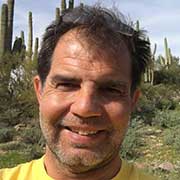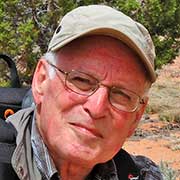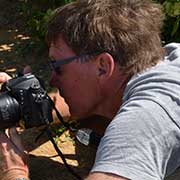Programme 8-9-10 September 2017
-
Day 1
-
Plant sales
-
Opening and lecture
Guillermo Rivera
Argentina

Baja California: From San Diego to Cabo (en)
Guillermo Rivera was born in Argentina. He is owner of Plant Expeditions (formerly South America Nature Tours), a company dedicated to the organization of tours for the last 15 years, throughout South America (Chile, Argentina, Brazil, Peru, Colombia, Bolivia, Ecuador), Mexico, South Africa, Madagascar and Namibia with emphasis on plants (cacti, bromeliads and orchids) and birds.
Guillermo is also a former researcher at the University of Cordoba, Argentina. He has a BS degree in Biology University of Cordoba, a MS Marine Biology Northeastern University and a PhD in Botany University of Cordoba.The Baja Peninsula is one of Mexico's richest areas for plants. Cactus species are abundant, Ferocactus, Echinocereus, Mammillaria, Stenocereus, Lophocereus and of course chollas! Because of its isolation the peninsula includes quite a few endemics, like Pachycereus pringlei, Echinocereus lindseyi, Lophocereus schottii, among others. Many other interesting plants grow in Baja: Dudleya, Agave, Fouquieria, Euphorbia, Beaucarnea, etc. The scenery is spectacular, clear water, beaches, and of course, a visit to a few islands completes this magic trip!
-
Cafetaria
Social gathering
-
Day 2
-
Plant sales
-
Lecture
Bob Potter
UK

An Euphorbia Odyssey (en)
I have been interested in cacti and succulents from a very early age, my first plants were given to me by my Grandfather when I was 3 years old and since then I have always continued the interest. Together with my wife Beryl I lived in Yemen for three years and Sudan for another year. During that time we discovered many species of plants and were instrumental in bringing many old species back into cultivation. In 1981 we started our plant nursery, Toobees Exotics, and have only just last year ceased trading. Beryl and I made our first journey to Madagascar in 1989 and since then I have been back several times as well as visiting South Africa, Ethiopia, Zimbabwe and once again back into Yemen. One of my special interests has been the plants of Madagascar but I have a fascination for all types of succulent plants, bulbs, cycads and palms.
The lecture shows many species of Euphorbia together with a few other succulents and their habitats, encountered on my travels in South Africa, Ethiopia, Madagascar, Zimbabwe and Yemen.
-
Lecture
Thomas Brand
Germany

Aug' in Aug mit der Schmierlaus - Pflanzenschutz bei sukkulenten Pflanzen (de)
Eye in eye with the mealy bug - Plant protection for succulent plants
Thomas Brand is a qualified gardener, horticulturist and plant pathologist. His professional focus is on pests and diseases of plants. He is in charge of the department of ornamentals, tree nurseries and public greens in the plant protection service of Lower Saxony (Northern Germany). For 30 years he has een a member of the Deutsche Kakteen-Gesellschaft, and for 3 years editor of the journal “Kakteen und andere Sukkulenten”. He spends his spare time in the garden, the greenhouse and at the computer.
Dealing with living organisms – regardless if human, animal or plant – one has to deal with diseases and death. That’s nature, the cycle of growth and decay. Plants are a food source and habitat of many pathogens and pests. Succulent plant enthusiasts are most likely to face problems such as spider mites, mealy bugs and fungal rot. To know how to prevent and control the inevitable foes is crucial for the prosperity of plants and grower.
-
Lecture
Jean Bonnefond
France

Sclerocactus in habitat (fr)
Jean Bonnefond discovers the United States at the beginning of the 1970s. He is immediately fascinated by the landscapes and national parks he visits, but also by the cacti he sees, especially Ferocactus. Next he decides to travel first through West America, then through Mexico, to learn more about these cacti and the two other genera he cherishes, Pediocacus and Sclerocactus. Since the end of the 1980s he spends most of his time in their cultivation and to the writing of articles on these plants in French and other periodicals.
The diorama presentation is on the plants of the genus Sclerocatus in their habitat. Their spination is the guideline in the discussion of the different species, not only to distinguish them from each other, but also to situate them in their habitat in West America.
-
Cafetaria
Social gathering
-
Day 3
-
Plant sales
-
Lecture and Closing
Wiebe Bosma
The Netherlands

Op zoek naar Caralluma's in India (nl) / Searching for Carallumas in India (en)
Wiebe Bosma is interested in cacti and other succulent plants for more than 40 years. He started with the hobbey as a teenager and has now a greenhouse of about 24 m2 with a mixed collection. This collection consists mainly of cacti and Stapelias, but one will encounter as well small Aloes, Euphorbias, Gasterias en Haworthias. Many of these plants are raised from seed. In the past years Wiebe has made several travels to see the plants in their habitat, 'cactus travels' in South America' as well as 'succulent plants travels' in Africa and Asia.
His last travel brought him to India in search of the Carallumas growing in this country. In his report of this travel, not only Carallumas but also other succulent plants, other plants and animals, the people and landscapes will be presented.
Lecture in Dutch and English.